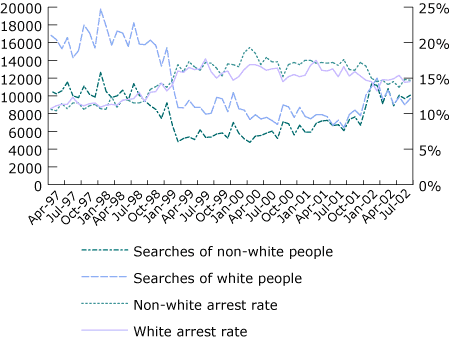Contents
Report 14 of the 28 Nov 02 meeting of the Equal Opportunities & Diversity Board and gives an overview of changing stop and search activities since 1998.
Warning: This is archived material and may be out of date. The Metropolitan Police Authority has been replaced by the Mayor's Office for Policing and Crime (MOPC).
See the MOPC website for further information.
Stop and search
Report: 14
Date: 28 November 2002
By: Commissioner
Summary
This report gives an overview of changing stop and search activities since 1998, and comments on major changes.
A. Recommendations
Members are asked to note the report.
B. Supporting information
Overview of stop-search patterns
1. Chart 1 shows the changing PACE stop-search figures and related arrest rates, since April 1997. It can be seen that there was a substantial reduction in the number of stop-searches in the last quarter of 1998 and first quarter of 1999, both for white and non-white persons. This was accompanied by a gradual increase in the arrest rates for white and non-white persons.
2. During 2000 and 2001 service-wide stop-search levels and arrest rates remained fairly steady, although there was a gradual convergence of numbers of white and non-white persons searched.
3. Early in 2002 there was a marked increase in the number of stop-searches, both of white and non-white persons. At the same time a slight reduction in arrest rates is seen. The arrest rates for white and non-white persons stopped remain very close, suggesting that use of stop-search powers is carried out in similarly targeted ways for these broad groups.
Chart 1: White and non-white stop-searches, and resulting arrests, MPS April 1998 onwards

Complaints
4. Looking at total complaints, the proportions of complaints made by different ethnic groups remained steady in the first six months of 2002/03 compared with the previous year, with 47% of complaints made by white persons, 28% by black persons and 8% by asian persons.
5. This contrasts with the figures for complaints related to stop-search, where the proportion made by white persons has increased from 28% in 2001/2 to 39% in 2002/03. However unlike total complaints, the majority of complaints relating to stop-search continue to be made by non-white persons.
6. This apparent disparity is mainly accounted for by the higher proportion of non-white persons being stop-searched. For 2002/3, 0.12% of white stop-searches and 0.17% of non-white stop-searches have led to complaints.
Operation Safer Streets
7. The “Performance Report: Street Crime” provided to the November Planning Performance and Review Committee gave an overview of the impact of Operation Safer Streets on stop-search activity, comparing April to August 2002 with the same period in 2001. This showed that the number of stop-searches carried out on the OSS boroughs (phases I and II) had increased by 44% and 47% for white and non-white persons respectively. For non-OSS boroughs these increases stood at 2% and 5%.
8. These OSS boroughs accounted for two-thirds of MPS stop-search activity in April to August 2001, this had risen to 75% in April to August 2002. These are also boroughs which stop-search more non-white persons than white persons, compared with non-OSS boroughs where the majority of persons stopped are white.
9. Whilst residential population is of limited use as an indicator of street population, it is an indicator of the differing nature of boroughs. The OSS boroughs have a 72% white population (2000 ONS mid-year estimate), compared with 87% white population for non-OSS boroughs. It is therefore not surprising that the OSS boroughs stop-search a higher proportion of non-white persons overall.
10. A similar pattern is seen for stop-searches of asian persons. OSS boroughs recorded 14% of their stops as being of asian persons in April to August 2001 and April to August 2002, whereas the equivalent figure for non-OSS boroughs was 9% for 2001 and 10% for 2002. Again, this differential is supported to a degree by the asian population, which is estimated at 9.5% for OSS boroughs and 5% for non-OSS boroughs.
11. In conclusion, it appears that the changing profile of stop-search during Operation Safer Streets is more due to a focus on boroughs with higher non-white populations, which also have higher street crime levels, than changing ethnic patterns of stop-search on individual boroughs.
12. This link of high street crime levels with higher non-white populations is intrinsically linked to other socio-economic factors, for example deprivation. It is essential that the MPS and MPA work with partners to better understand and tackle these links, and this work is being progressed through the London Street Crime Management Board.
Vehicle stops
13. PACE vehicle stops cannot be broken down by ethnicity. Where a PACE vehicle stop leads to the search and arrest of a person, this is recorded in place of the vehicle stop. The number of vehicle stops rose slightly in 2001/02 to 2,920 compared with 2,809 in 2000/01.
C. Equal opportunities and diversity implications
1. The issue of ethnicity in relation to stop-search remains an area of concern for many communities and the MPS. The data presented in this report should not be seen in isolation but a way of informing for wider debate on the baseline from which a meaningful assessment can be made.
2. The phased introduction of recommendation 61 of the Lawrence Inquiry should assist with the transparency of the data recorded.
D. Financial implications
Costs associated with stop-search activity are contained within existing budgetary provision.
E. Background papers
None
F. Contact details
Report author: Carol McDonald, MPS Corporate Performance and Analysis Unit
For more information contact:
MPA general: 020 7202 0202
Media enquiries: 020 7202 0217/18
Send an e-mail linking to this page
Feedback